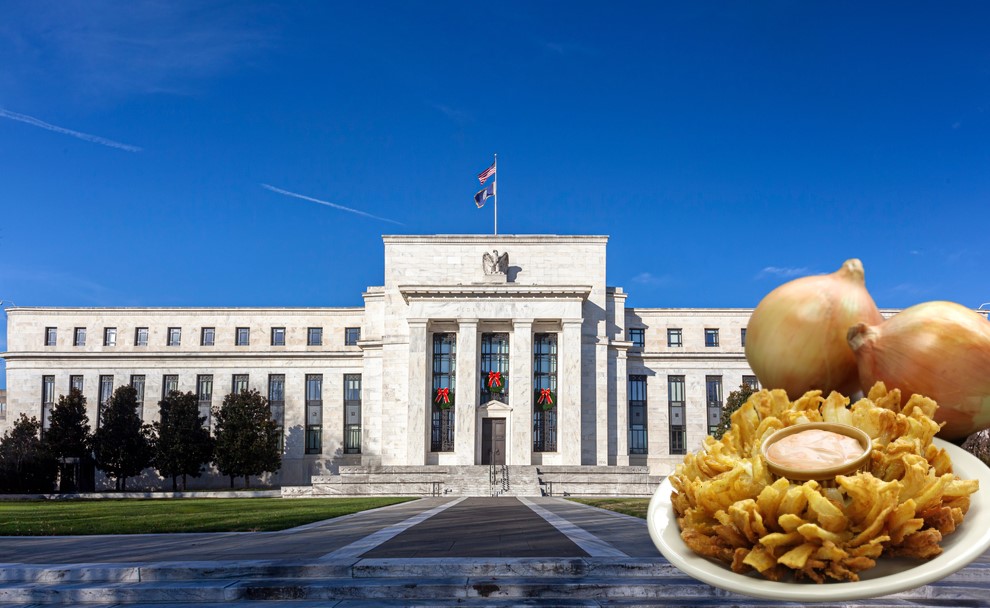Bull vs. Bear is a weekly feature where the VettaFi writers’ room takes opposite sides for a debate on controversial stocks, strategies, or market ideas — with plenty of discussion of ETF ideas to play either angle. For this edition of Bull vs. Bear, Nick Peters-Golden and Elle Caruso debate the investment case for consumer discretionary stocks in the current economic environment.
Nick Peters-Golden, staff writer, VettaFi: Hi Elle! Glad to chat with you today about the American consumer and discretionary spending. In my book, the key metric for the American economy should be total sales for the Blooming Onion. I honestly can’t get enough – but from the bear perspective, a dark cloud looms over my favorite restaurant chain appetizer. What’s the bull view on restaurants, travel, and other fun discretionary spending?
Elle Caruso, staff writer, VettaFi: Hi Nick, it’s great that we finally get the opportunity to face off in a Bull vs. Bear column. I like the idea of measuring the strength of the U.S. economy by Blooming Onion sales per capita, but I also like strong job data – and that’s what we saw in January when employers added more than half a million jobs. At the same time, U.S. housing markets are showing signs of stabilizing – or even rebounding – and economists are softening their expectations of a severe recession. We’re also seeing further proof of consumers’ resiliency, as retail sales rose 3% in January from the prior month (6.4% YoY). Thus, I have a bullish outlook for consumer discretionary stocks as they comprised the top-performing sector in January, which was up 15.11% during the month, and remain well positioned.
Peters-Golden: Listen, these are certainly some substantial consumer spending numbers. It’s clear Americans took advantage of a disastrously warm winter to get back to restaurants and spend freely on cars, appliances, and all our beautiful little plastic idols that will one day carpet the sea.
No matter how much we want to ignore it, there are consequences to this spending. Think of this – the Federal Reserve raised rates last year at the fastest pace since the 1980s. Then, Fed Chair Jerome Powell raised rates another 25 basis points. Yet, here we are, with barnstorming job numbers and hot reports from both the consumer price index (CPI) and the producer price index (PPI).
Let’s not underplay how hot price growth still is – inflation came in hotter in January than expectations by economists surveyed by the Wall Street Journal and the Dow Jones. A 20 basis point miss for both on a year-over-year basis, while core PPI, excluding food and energy, also came in 20 basis points higher than expected last month. Based on the aforementioned amount and pace of hikes, realistically, you’d want to see more progress than that by now.
That may as well kill the idea that there would be rate cuts later this year, and instead, we may be looking at least two more rate hikes, according to a survey of economists – all of whom underscored that the bigger risk is not a peak of 5% to 5.25%, but rates peaking even higher than that.
As someone who loves consuming things, it brings me no pleasure to say that consumer discretionary spending may be sacrificed to meet that goal. Markets have already started pricing in the possibility of even four rate hikes this year. Yes, earnings can stay resilient, but the longer we go without paying for this excess, the more painful the rate hikes will become.
Caruso: It’s true, Goldman Sachs and Bank of America are predicting three more rate hikes this year, increasing past estimates after new data pointed to persistent inflation and a tight labor market. At the same time, UBS has estimated the Fed will ease interest rates at the September meeting this year.
I wouldn’t put too much behind these estimates, however. Economists shift their expectations with every new data point, meaning this is just another development. After all, if we look back to 2022, Wall Street analysts may have been able to accurately predict corporate earnings for S&P 500 companies but utterly failed in anticipating the bear market in stocks and bonds – the bigger story. This isn’t a deviation from the norm either – economists’ recession forecasting record is extremely poor. Therefore, listening to the markets – as opposed to the analysts – is a better way to assess the economy and the probability of a recession.
Amid the background noise of analysts’ worsening expectations, consumer discretionary stocks’ performance remains strong, with a constructive outlook, and that’s telling of what the market thinks of consumers’ resiliency. The Consumer Discretionary Select Sector SPDR Fund (XLY) has gained nearly 17% year to date as of February 17, and the Invesco S&P 500 Equal Weight Consumer Discretionary Sector ETF (RCD) has climbed almost 14% during the same period.
Peters-Golden: Americans’ pockets are starting to dry up themselves with all this inflation.
Earnings for the firms in this space are impacted by consumer demand, ability to spend, and input costs. In this case, the former is in jeopardy – U.S. credit card debt jumped 18.5%, according to the latest quarterly report available, to a record $930.6 billion.
More than just the amount of debt, though, is the cost of holding it. One could argue that Americans might have room to stretch out their credit lines and keep the good times rolling, but the cost of credit card debt has risen to the highest point on record with data that goes back to 1995. Charlie Billelo, chief market strategist at Creative Planning, asks the key question – how long before that impacts consumer spending?
That tightness will impact consumer discretionary bottom lines, with a drop in unemployment claims a cherry on top. It’s a precarious situation for this market sector and one that drives me to strategies with a multi-asset, go-anywhere approach like the iMGP RBA Responsible Global Allocation ETF (IRBA), which uses Richard Bernstein Advisors’ focus on the profits cycle to identify and invest in whichever asset class is appropriate for rising, or dropping, profits.
Caruso: Looking holistically, total household debt reached $16.90 trillion during the fourth quarter of 2022 (an increase of 2.4%). Within that, as you mentioned, credit card balances jumped to $986 million, a new series high, but there is constructive data to be found in this report: Mortgage originations, including refinances, fell to $498 billion last quarter, representing a return to lower levels last seen in 2019, and auto loan balances grew at a more moderate rate, reflecting activity consistent with pre-pandemic levels.
As both credit card debt and aggregate limits on accounts increased, the share of debt becoming delinquent rose last quarter – but this needs to be put into perspective as this follows two years of historically low delinquency transitions. The relatively slight uptick in delinquency transition rates shows some signs of stress largely isolated amongst younger borrowers who are beginning to miss some credit card and auto loan payments. From a high-level perspective, balance-weighted delinquencies remain at or below pre-pandemic levels, which is why I think the Direxion Daily Retail Bull 3X Shares (RETL) and the Direxion Daily Consumer Discretionary Bull 3X Shares (WANT) remain well-positioned in the current environment for experienced investors. RETL and WANT have jumped nearly 56% and 53% YTD, respectively.
Peters-Golden: Perhaps one of the most critical pieces of this conversation surrounding U.S. consumer discretionary spending is that a lot of this recent spending bump could very well be temporary. That January spending that looks so exciting? It could very well be the spending that didn’t happen in the 2022 holiday season, which failed to meet expectations, according to the National Retail Foundation.
What’s more, the spending that did happen in the holiday season increasingly is going to gift cards, which adds to the delayed spending bump argument. The Commerce Department counts sales from gift certificates not when purchased initially but when they’re redeemed. Restaurant gift cards could have been a notable contributor to its role as the leading spending category for January.
There are other temporary factors, as well – January saw Social Security recipients get a COLA increase, yes, but how much of that will go to spending on consumer goods, and how much will go towards keeping up with more necessary expenditures?
Nearly all seniors polled in a recent survey by the Senior Citizens League don’t believe they’ll be able to make up for all the hits they’ve borne from inflation this year, even with the COLA increase. More than half, meanwhile, don’t believe that the COLA increase won’t be enough to keep up with rising costs.
Finally, so much of this spending is built off one major factor – travel. That includes obvious travel-related sectors like hospitality and airlines, but also, crucially, it includes automobile sales. Auto dealers have seen their numbers pop largely thanks to fleet sales, in which vehicles are sold in bulk to places like rental car companies.
While there has been pent-up demand for such sales from rental car companies, all it takes is a particularly bad COVID outbreak or, perhaps more likely, a dip in travel spending to create a ripple effect across several key consumer spending-related industries.
This consumer spending is weaker than it seems, and with rates rising and credit card debt piling up, I think we’re looking at a train that’s losing momentum. It may be a better time for international equities in a strategy like the Franklin International Core Dividend Tilt Index ETF (DIVI) or a safer equity offering like the American Century Quality Preferred ETF (QPFF).
Caruso: Nick, you bring up some really good points, but we should dig deeper into consumer confidence and sentiment. The Consumer Confidence Survey details consumer attitudes, buying intentions, vacation plans, and consumer expectations for inflation, stock prices, and interest rates. Looking under the hood, consumer confidence fell the most for households under 35 or earning less than $15,000 – the same group disproportionately affecting the small uptick in delinquency transition rates.
While consumer confidence declined in January, it remains above the 2022 low seen in July. According to the survey, consumers’ assessment of present economic and labor market conditions improved at the start of 2023, but the Expectations Index retreated in January, reflecting concerns about the economy over the next six months.
Notably, consumers expect their incomes to remain relatively stable in the months ahead, and purchasing plans for autos and appliances held steady, another constructive indicator for consumer discretionary ETFs, particularly the First Trust S-Network Future Vehicles & Technology ETF (CARZ).
For investors worried about concentration risks and overweighting any sub-sector, the Fidelity MSCI Consumer Discretionary Index ETF (FDIS) and the Vanguard Consumer Discretionary ETF (VCR) offer diversified exposure to the consumer discretionary sector.
Peters-Golden: We’ve done more than a few Bull vs. Bear chats by now, but this is the first time, as the bear, that I am rooting for the bull case. I’ve seen too many of my beloved restaurant chains suffer from the ups and downs of the American economy and the cruel whims of the American consumer. Perhaps I’m just a hopeless Cassandra, but regardless, I’m stocking up on my Outback (BLMN) gift cards.
Caruso: Well, perhaps I’m an optimist, but I think your local Outback will be just fine. After all, buyer demand improved during the fourth quarter of 2022 through January despite the higher-rate environment. There’s a lot of uncertainty right now, but with inflation cooling while jobs numbers remain strong, the Fed might just manage to engineer a soft landing after all.
For more news, information, and analysis, visit the Leveraged & Inverse Channel.









